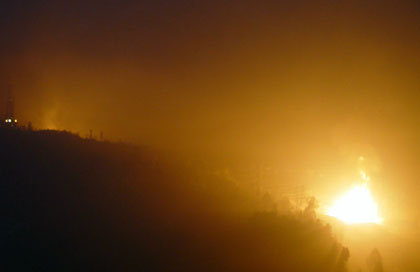Lei Xiong – December 12, 2006 – 9:53am
While enjoying an impressive increase in meat consumption from 13.4
kilograms per person in 1980 to 53 kilograms in 2004, China is also
experiencing the negative impacts of this “livestock revolution,”
according to agronomists. When the country introduced livestock factory
farms in the late 1970s to meet the rising demand for meat, milk, and
eggs, few policymakers foresaw the “serious environmental consequences”
of this intensive production system, Cheng Xu, a professor at China
Agricultural University and vice-chairman of the Chinese Society of
Farming System Research, observed recently.
Speaking in early December at a two-day food conference sponsored by
the European Action on Global Life Sciences (EAGLES) in Hangzhou,
eastern China, Cheng noted that the large-capacity “confined animal
feeding operations” (CAFOs), though highly efficient, “have broken the
ecologically benign interlinks between crop cultivation, feedstuff, and
manure handling in traditional livestock rearing.”
Cheng’s studies show that by the mid-1990s, such livestock factory
farms, non-existent in China before 1979, were able to supply 15
percent of China’s pork, 25 percent of its eggs, 40 percent of its
broiler chickens, and 50 percent of its milk. Yet these farms,
constructed mostly near large cities, “also produced huge animal
wastes, which, mostly discharged untreated, have caused serious
pollution to water and air,” Cheng told workshop participants. The
event drew more than 30 agronomists from Europe, the United States,
China, and the Food and Agriculture Organization of the United Nations.
According to presenter Wu Weixiang, associate professor with the
Department of Environment Engineering at Zhejiang University, a total
of 2.7 billion tons of livestock manure is produced every year across
China, an amount 3.4 times the industrial solid waste generated
nationwide. “Animal manure has become one of the main pollution sources
in China,” he said.
In Zhejiang, Wu noted, the livestock industry, led by some 900
sizable pig, dairy, and chicken farms, produced 26.7 million tons of
manure in 2000. This waste contained an estimated 687,000 tons of
chemical oxygen demand (COD) and 512,000 tons of biochemical oxygen
demand (BOD)—both indexes of water pollution—as well as considerable
amounts of other pollutants such as nitrogen, ammonia nitrogen, and
phosphorous. “Many of these substances were discharged directly,
without any treatment,” Wu observed, adding that “animal manure has
been a major contributor to surface water contamination in Zhejiang.”
Professor Cheng Xu, citing findings of a study conducted jointly by
Qinghua University and China Agricultural University, said agricultural
production accounted for an estimated 70 percent, 60 percent, and 35
percent, respectively, of the total nutrient load (including nitrogen
and phosphorus) flowing into the freshwater lakes of Dianchi in Yunnan,
Chaohu in Anhui, and Taihu in Jiangsu. The three lakes are among the
worst-polluted freshwater lakes in China. “Much of the agricultural
pollution should be attributed to livestock excretion,” Cheng said.
In Zhejiang, only 6.2 percent of animal manure is applied to
cropland, according to Wu Weixiang. Overall, only about 5 percent of
China’s manure is treated, due to limited facilities and treatment
capacity. And Cheng noted that of the more than 20,000 livestock
factory farms of medium and large size across China, only 3 percent has
been equipped with waste treatment facilities.
In light of the
many problems caused by factory farms, Cheng echoed the concerns of
many international agronomists by pointing to the need to “reflect on
the livestock revolution.” He suggested that what China needs is a “new
type” of livestock revolution, featuring the full utilization of
feedstock resources, the recycling of wastes and other materials, and
integrated crop cultivation and animal husbandry, resulting in the
production of biogas as a way to close the recycling circle.
Dr. Ge Backus, head of the section market and networks of the
Agricultural Economics Research Institute of the Netherlands, offered
his country’s experience with environmental management in the livestock
industry. Of particular interest to the workshop’s Chinese audience was
the 22-year-old Dutch manure policy, which is aimed at reducing nitrate
and phosphate leaching from livestock wastes into groundwater,
emissions of ammonia and nitrous oxide into the atmosphere, and
eutrophication of surface waters.
Backus also elaborated on how to develop an effective
agro-environmental policy to regulate the livestock industry. “Modern
agriculture is causing more environmental problems than industry, but
is not as well regulated yet as to the emissions,” he said. “You have
to have a sense of urgency to build up a public environmental policy
for livestock.”
Several Chinese agronomists attending the EAGLES food workshop are
feeling that urgency. “We lack the regulations to curb greenhouse gas
emissions and other environmental problems caused by the livestock
industry,” said Professor Li Ji, director of the Department of Ecology
and Ecological Engineering of China Agricultural University. But Li
noted that some big regions, including the cities of Beijing, Shanghai,
and Hangzhou, and Jiangsu province, have issued policy incentives to
encourage farmers to treat animal wastes to alleviate the pollution.
Meanwhile, Chinese researchers have developed several new models of
livestock farming, applying integrated technologies for ecological
treatment and utilization of animal wastes, which have shown efficiency
in removing CODs and BODs. “Environmental problems caused by the
livestock industry can be alleviated with integrated technologies,” Wu
Weixiang of Zhejiang University said, adding that “economic profits can
be obtained from ecological utilization of animal wastes.” Wu has been
involved with four such experimental models, and is well aware that the
“development of cost-effective treatment systems for livestock wastes
plays an important role in pollution control.”
Technorati Tags:
china,
livestock factory,
agro-envrironment 







